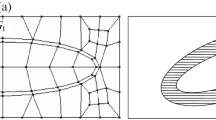Abstract
A systematic presentation of the modified Saint-Venant semi-inverse method is given in the example of constructing solutions of differential equations of the theory of elasticity with a small parameter for a long strip. The method is interpreted as iterative. The solution convergence is provided by a small thin wall parameter in accordance with the Banach contraction mapping principle. The sequential computation of the unknowns takes place with the help of the Picard operators known in the literature, so that the unknowns computed by one equation are the input magnitudes for the next equation, and so on. The fulfillment of the boundary conditions on the long edges leads to the equations for slowly and quickly varying singular components of the solution. The solutions of singularly perturbed equations satisfy the conditions lost in the classical theory and describe the stress concentration at the corners of the strip.
Similar content being viewed by others
REFERENCES
A. E. H. Love, A Treatise on the Mathematical Theory of Elasticity (Cambridge: Univ. Press, 1927).
K. O. Friedrichs, “Asymptotic phenomena in mathematical physics,” Bull. Am. Math. Soc. 61 (6), 485–504 (1955).
E. I. Grigolyuk and I. T. Selezov, “Non-classical theory for vibrations of bars, plates and shells,” in Results of science and Technology. Mechanics of Rigid Deformable Body (VINITI, Moscow, 1973), Vol. 5 [in Russian].
Ye. M. Zveryaev, “Analysis of the hypotheses used when constructing the theory of beams and plates,” J. Appl. Math. Mech. 67 (3), 425–434 (2003).
A. N. Kolmogorov and S. V. Fomin, Elements of the Theory of Functions and Functional Analysis (Dover Publ., New York, 1999).
E. Kamke, Differentialgleichungen. Lösungsmethoden und Lösungen I. Gewöhnliche Differentialgleichungen (Akadem. Verlag, Leipzig, 1942).
R. De Pascalis, M. Destrade, and G. Saccomandi, “The stress field in a pulled cork and some subtle points in the semi-inverse method of nonlinear elasticity,” Proc. R. Soc. Ser. A. Math., Phys., Eng. Sci. 463 (2087), 2945–2959 (2007).
R. De Pascalis, K. R. Rajagopal, and G. Saccomandi, “Remarks on the use and misuse of the semi-inverse method in the nonlinear theory of elasticity,” Quart. J. Mech. Appl. Math. 62 (4), 451–464 (2009).
E. Bulgariu, “On the Saint-Venant’s problem in microstretch elasticity,” Libertas Math. 21, 147–162 (2011).
S. Chiriëta, “Saint-Venant’s problem and semi-inverse solutions in linear viscoelasticity,” Acta Mech. 94, 221–232 (1992).
L. Placidi, “Semi-inverse method a la Saint-Venant for two-dimensional linear isotropic homogeneous second-gradient elasticity,” Math. Mech. Solids 22 (5), 1–19 (2015).
E. M. Zveryaev, Interpretation of Semi-Inverse Saint-Venant Method as Iteration Asymptotic Method. Shell Structures: Theory and Application (Taylor&Francis Group, London, 2006), pp. 191–198.
Ye. M. Zveryaev, “A consistent theory of thin elastic shells,” J. Appl. Math. Mech. 80 (5), 409–420 (2016).
Ye. M. Zveryaev and G. I. Makarov, “A general method for constructing Timoshenko-type theories,” J. Appl. Math. Mech. 72 (2), 197–207 (2008).
E. M. Zveryaev and L. V. Olekhova, “Reduction of 3D equations of stress strain behavior of the plate made of composite material to 2D equations on the base of mapping contraction principle,” Preprint No. 95 (Keldysh Institute of Applied Mathematics, Moscow, 2014) [in Russian].
ACKNOWLEDGMENTS
The author is grateful to P. S. Krasil’nikov for his constructive remarks concerning the paper.
Author information
Authors and Affiliations
Corresponding author
Additional information
Translated by N. Semenova
About this article
Cite this article
Zveryaev, E.M. Saint-Venant–Picard–Banach Method for Integrating Thin-Walled System Equations of the Theory of Elasticity. Mech. Solids 55, 1042–1050 (2020). https://doi.org/10.3103/S0025654420070225
Received:
Revised:
Accepted:
Published:
Issue Date:
DOI: https://doi.org/10.3103/S0025654420070225




